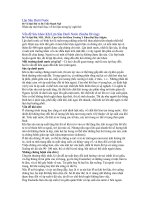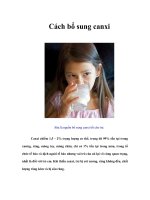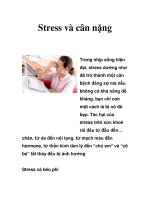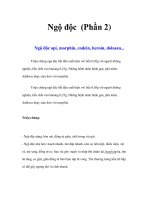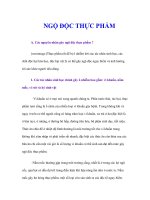Tài liệu Avian female reproductive system pptx
Bạn đang xem bản rút gọn của tài liệu. Xem và tải ngay bản đầy đủ của tài liệu tại đây (594 KB, 6 trang )
1
AFS-
Anyone raising chickens for eggs, whether for
eating or for incubation, should have an under-
standing of the female avian reproductive sys-
tem so that they are better able to understand
any problems that may occur and how to cor-
rect them.
Avian female reproductive system
Jacquie Jacob, Tony Pescatore and Austin Cantor
The avian reproductive system is VERY differ-
ent from that of mammals. Nature has de-
signed it to better suit the risks associated with
being a bird. Unless you are a bird of prey (like
a hawk, eagle or falcon), you are faced with
Figure 1. Model showing the internal organs of the female chicken
2
the fact that everyone is trying to eat you! Be-
ing close to the bottom of the food chain re-
quires the development of unique strategies for
feeding and reproducing—all while retaining
the ability to fly.
The reproductive strategy of most mammals,
especially primates (such as chimpanzees,
apes and gorillas), is to produce only a few off-
spring and devote a considerable amount of
time to caring for them. Once they are full
grown and ready to take care of themselves
the parent’s job is complete.
Birds (with some exceptions, of course) have
developed a strategy where they produce mul-
tiple offspring and tend to their needs for only a
short period of time before ‘tossing them into
the wind,’ sometimes literally as well as figura-
tively speaking. The amount of time they de-
vote to caring for their offspring depends on
whether they are precocial or altricial, with the
latter requiring more post-hatch parental care.
vided in the egg before it is laid. The parts of
the avian egg, with and without an embryo, are
shown in Figure 2.
The female reproductive system of the chicken
is shown in Figure 3 below. It is divided into
two separate parts: the ovary and the oviduct.
In almost all species of birds, including chick-
ens, only the left ovary and oviduct are func-
tional. Although the embryo has two ovaries
and oviducts, only the left pair (i.e., ovary and
oviduct) develops. The right typically regresses
during development and is non-functional in
the adult bird. There have been cases, how-
ever, where the left ovary and oviduct have
been damaged and the right one has devel-
oped to replace it. In some birds, such as
hawks, it is the right, and not the left, ovary
and oviduct that typically develops. Kiwis are
Figure 2. Interior views of chicken's egg be-
fore and after incubation.
While mammals typically give birth to their
offpsring, the offspring of birds develop outside
the body of the parents - in eggs. When carried
in the womb, mammalian embryos receive
their daily requirement for nutrients directly
from their mother via the placenta. For birds,
however, all the nutrients that will be needed
for the embryo to fully develop must be pro-
Figure 3. Parts of the reproductive tract of a
chicken
Precocial birds are well de-
veloped when hatched and
are able to get up and walk
around on their own very
quickly. This includes most
of the domestic poultry species - chickens,
ducks, turkeys, etc. The exception is pigeons.
Altricial birds are still underde-
veloped when they hatch and
require a considerable amount
of parental care before they are
able to get up and survive on
their own. This would include
pigeons and passerine birds (i.e., perching/
song birds).
3
unique in that both the left and right ovaries
develop, though it is only the left oviduct that
develops. Ova from both ovaries will pass
down the same oviduct, though not typically at
the same time.
The ovary is a cluster of developing yolks or
ova and is located midway between the neck
and the tail of the bird, attached to the back.
The ovary is fully formed when pullet chicks
hatch, but it is very small until the chicks reach
sexual maturity. At hatch, pullet chicks have
tens of thousands of potential eggs (i.e., ova)
which theoretically could be laid. Most of
these, however, never develop to the point of
ovulation. So the maximum number of eggs a
hen can lay is determined when she hatches
since no new ova are added once the chick
has hatched.
Each ovum (singular form of ova) starts out as
a single cell surrounded by a vitelline mem-
brane. As the ovum develops, yolk is added.
The color of the yolk comes from fat soluble
pigments called xanthophylls contained in the
hen’s diet. Hens fed diets with yellow maize,
or allowed to range on grass, typically have
dark yellow yolks. Hens fed diets with white
maize, sorghum, millet or wheat typically have
pale yolks. The color of the yolks from these
hens can be ‘improved’ by the addition of mari-
gold petals to provide the desired level of xan-
thophylls in the yolk.
Ovulation is the term used for the release of
the mature ovum from the ovary into the sec-
ond part of the female reproductive system,
the oviduct. The ovum, which is enclosed in a
sac, ruptures along the suture line or stigma
(see Figure 4).
Occasionally the vitelline membrane is dam-
aged and pale spots or blotches develop on
the yolk. This is referred to as mottling. Al-
though the appearance of the yolk is changed,
there is no effect on the egg’s nutritional value
or flavor. A slight degree of yolk mottling is nor-
mal and is not typically noticed by consumers.
A high incidence of yolk mottling, however, ad-
versely affects consumer acceptance. The use
of cottonseed meal (which contains gossypol)
and sorghum (which contains tannin) in the
diet can also increase the incidence of mot-
tling. A calcium deficient diet will also have the
same effect.
The female reproductive system is sensitive to
light exposure, especially the number of hours
of light in a day. The release of the next ova
typically occurs 30-75 minutes after the previ-
ous egg has been laid. If the egg was laid too
late in the day the next ovulation will wait till
the next day and the hen will have a day when
she does not lay an egg.
The second major part of the female chicken’s
reproductive system is the oviduct. The ovi-
duct is a long convoluted tube (25-27 inches
long when fully developed) which is divided
into five major sections. They are the infun-
dibulum or funnel, magnum, isthmus, uterus or
shell gland, and vagina.
The first part of the oviduct, the infundibulum
or funnel, is 3-4 inches long, and engulfs the
ovum released from the ovary. ‘Funnel’ is an
inaccurate choice of name for this part since it
gives the vision of the infundibulum waiting for
the ovum to fall into it, which is not the case.
Instead the released ovum stays in place and
the muscular infundibulum moves to surround
it. The ovum or yolk remains in the infundibu-
lum for 15-18 minutes. Fertilization, if it is go-
ing to occur, takes place in the infundibulum.
Figure 4. Photograph of the ovary of female
chicken, indicating the location of the stigma
on an ovum
Stigma
4
The next section of the oviduct is the magnum
which is 13 inches long and is the largest sec-
tion of the oviduct as its name implies (from
the Latin word for ‘large’). The ovum or yolk
remains here 3 hours during which time the
thick white or albumen is added.
The third section of the oviduct is the isthmus
which is 4 inches long. The developing egg re-
mains here for 75 minutes. The isthmus, as its
name implies, is slightly constricted (The term
‘isthmus’ refers to a narrow band of tissue con-
necting two larger parts of an anatomical struc-
ture). The isthmus is where the inner and outer
shell membranes are added.
The next section of the oviduct is the shell
gland or uterus. The shell gland is 4-5 inches
long, and the ‘egg’ remains here for 20 plus
hours. As its name implies, the shell is placed
on the egg here. The shell is largely made up
of calcium carbonate. The hen mobilizes 47%
of her body calcium from her bones to make
the egg shell, with the diet providing the re-
mainder of the required calcium. Pigment
deposition, if there is any, is also done in the
shell gland.
The last part of the oviduct is the vagina which
is about 4-5 inches long and does not really
play a part in egg formation. The vagina is
made of muscle which helps push the egg out
of the hen’s body. The bloom or cuticle is also
added to the egg in the vagina prior to ovi-
position (the laying of the fully formed egg).
Near the junction of the vagina and the shell
gland, there are deep glands known as sperm
host glands. They get their name from the
fact that they can store sperm for long periods
of time (10 days to 2 weeks). When an egg is
laid, some of these sperm can be squeezed
out of the glands into the oviduct so that they
can migrate farther up the oviduct to fertilize an
ovum. This is one of the really remarkable
things about birds; the sperm remain viable
at body temperature.
Birds lay eggs in clutches. A clutch consists of
one or more eggs laid each day for several
days, followed by a rest period of about a day
or more. Then another egg or set of eggs is
laid. Clutch size is species- and breed-specific.
For commercial egg layers clutch size is typi-
cally quite large. Clutch size, as well as the
numbers of clutches laid in a laying cycle, will
vary with species, but the principle is the
same.
In chicken hens, ovulation usually occurs in the
morning and under normal daylight conditions,
almost never after 3:00 PM. The total time to
form a new egg is about 25-26 hours. This in-
cludes about 3½ hours to make the albumen,
1½ hours for the shell membranes, and about
20 hours for the shell itself.
Ovulation of a yolk for the next egg in a clutch
occurs within an hour of laying the previous
egg, and so that each day the hen gets later
and later in her timing. As an analogy, she
"runs behind," like a clock that is improperly
adjusted. Eventually she gets so far behind
schedule that she would have to ovulate later
than 3:00 PM. Since hens do not typically ovu-
late after 3:00 PM, the next ovulation is de-
layed until at least the next day and egg laying
is interrupted. This delay results in the break
between clutches and the cycle repeats itself a
day or so later.
Occasionally, a hen will produce double-
yolked eggs. This phenomenon can be re-
lated to hen age but genetic factors are also
involved. Young hens sometimes release two
yolks from the ovary in quick succession. Dou-
ble-yolked eggs are typically larger in size than
single yolk eggs. Double-yolked eggs are not
suitable for hatching. There is typically not
enough nutrients and space available for two
chicks to develop to hatch. It has happened,
but it is rare.
It is rare, but not unusual, for a young hen to
produce an egg with no yolk at all. Yolkless
eggs are usually formed when a bit of tissue is
sloughed off the ovary or oviduct. This tissue
stimulates the secreting glands of the different
parts of the oviduct and a yolkless egg results.
Even rarer is an egg within an egg. This occurs
when an egg that is nearly ready to be laid re-
5
verses direction and moves up the oviduct and
encounters another egg in process of being
put together. The results is that the first egg
gets a new layer of albumen added and two
‘eggs’ are encased together within a new
shell. Such eggs are so rare that no one
knows exactly why they happen.
Another egg problem that is commonly noted if
you raise your own chickens is blood and meat
spots. Blood spots are normally found on or
around the yolk. The main cause is a small
break in one of the tiny blood vessels around
the yolk when it is ovulated. High levels of ac-
tivity during the time of ovulation can increase
the incidence of blood spots. Meat spots are
usually brown in color and are more often as-
sociated with the egg white. They are formed
when small pieces of the wall of the oviduct
are sloughed off when the egg is passing
through. In commercial operations, eggs with
blood or meat spots are typically identified dur-
ing candling and removed. It is rare, therefore,
to see these eggs in stores. The incidence is
higher in brown shelled eggs, and it is harder
to identify them when candling the darker col-
ored shells.
Other things occasionally go wrong when an
egg shell is being developed. The most obvi-
ous relates to shell texture (see Figure 6). Oc-
casionally the shell becomes damaged while
still in the shell gland and is repaired prior to
being laid. This results in what is known as a
‘body check.’ Occasionally there will be ‘thin
spots’ in the shell or ‘ridges’ will form. The
shells of such eggs, though not cracked, are
weaker than ‘normal’ eggs and should not be
used as hatching eggs.
Occasionally an egg will be laid without a shell.
It feels like a water balloon. The shell mem-
branes were placed on the yolk and egg white,
but it somehow slipped past the "shell mecha-
nism" and the shell wasn't deposited. The oc-
currence of the occasional shell-less egg is not
necessarily an indication of any health prob-
lem. If the incidence increases, however, there
may be a deficiency of calcium, phosphorus
and/or vitamin D. If the condition persists a vet-
erinarian should be consulted. Infectious Bron-
chitis and Egg Drop Syndrome have been
known to cause an increase in shell-less eggs.
Figure 5. An egg
with a blood spot on
the yolk.
A second category of problems is abnormal
shape (Figure 7). Such eggs do not fit well into
a typical egg carton or are more likely to break
during transport, so they are removed during
egg inspection and do not normally appear in
eggs sold in the store.
To be considered a hatching egg, the egg
should be a typical ‘egg shape.’ Abnormally
shaped eggs should not be used as hatching
eggs. In many cases it is not clear which is the
large end (and eggs should be incubated large
end up) or they may not properly fit in the egg
trays.
A. Pear-shaped egg B. Football-shaped egg
Figure 7. Examples of abnormally shaped
eggs
Figure 6. Examples of poor exterior egg qual-
ity related to shell texture
A. Body check B. Thin spot C. Ridges
6
Educational programs of Kentucky Cooperative Extension serve all people regardless of race, color, age, sex, religion, disability, or national origin. Issued in furtherance of Cooperative Extension
work, Acts of May 8 and June 30, 1914, in cooperation with the U.S. Department of Agriculture, M. Scott Smith, Director, Land Grant Programs, University of Kentucky College of Agriculture, Lexing-
ton, and Kentucky State University, Frankfort. Copyright 2011 for materials developed by University of Kentucky Cooperative Extension. This publication may be reproduced in portions or its entirety
for educational and nonprofit purposes only. Permitted users shall give credit to the author(s) and include this copyright notice. Publications are also available on the World Wide Web at
www.ca.uky.edu.
Issued 02-2011


